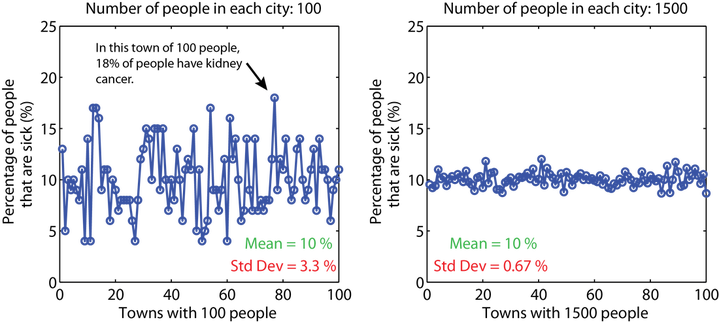WHY YOU ARE THE MOST AND LEAST LIKELY TO GET CANCER IN A SMALL TOWN
|
Another idea posed by my man, Alex.
Here's the riddle: The national average for getting kidney cancer is 10%. In some small rural towns, there is a way higher percentage of people getting kidney cancer than the national average (close to 20%). Why is this the case? Is it something in their lifestyle? Something that they are eating? Actually, this finding has to do with an interesting result of statistics!! Don't run away. Suppose there are 15 different sized towns ranging from 100 to 1500 people. There exist 100 of each sized town. It is a little confusing. Check out the table to better see what's going on. There are 100 towns with 100 people, 100 towns with 200 people, 100 towns with 300 people, and so on. Therefore, there is a total of 1,200,000 people. Suppose that 10% of the 1,200,000 people get kidney cancer (120,000 people). Now the people are randomly distributed across all the towns. It's not crazy to imagine that the average number of people who have cancer in each town is around 10%., regardless of the city size. This is true, but what varies dramatically across town size is the standard deviation. To see what I mean, check out the percentage of people sick in the 100 towns that have 100 people. Now compare this to the percentage of people sick in the 100 towns with 1500 people. In these plots, each point is a single town. |
If you average across the towns with 100 people, you get an average of 10% of people having cancer. Same with towns that have 1500 people. But look at the variability in the percentage of people who are sick in the smaller towns compared to the larger towns. Some towns with 100 people have a very high percentage of people with kidney cancer. Some 100 people towns have a very low percentage of people with kidney cancer. We can plot the results for all the different town sizes (shown below).
SO... We have our answer! The reason that it seems that some small rural towns have a higher percentage of people with kidney cancer is because there is a ton of variability in the percentage of people who have kidney cancer in small towns. This is known as under-sampling in the world of statistics. The less samples that you have (i.e. the less people you have in your town), the less certain you are of the mean.
If you didn't think about this issue from a statistical point of view, you may start a research project to determine what is going on in these small rural towns that causes them to be more susceptible to cancer. You may also realize that small towns are also the ones that have the lowest percentage of people with kidney cancer. Consequently, you could drive yourself mad trying to figure out what the people in these small towns are doing differently. Why do some small towns have a percentage of cancer patients higher than the national average, while these other small towns have a lower percentage?? In these types of questions and research, you must be very careful. In this simplified case, the results have nothing to do with food, hospitals, or lifestyles. Just stats.
This concept was worked on by Daniel Kahneman and Amos Tversky. Alex read about it in Kahneman's book called Thinking, Fast and Slow.
If you didn't think about this issue from a statistical point of view, you may start a research project to determine what is going on in these small rural towns that causes them to be more susceptible to cancer. You may also realize that small towns are also the ones that have the lowest percentage of people with kidney cancer. Consequently, you could drive yourself mad trying to figure out what the people in these small towns are doing differently. Why do some small towns have a percentage of cancer patients higher than the national average, while these other small towns have a lower percentage?? In these types of questions and research, you must be very careful. In this simplified case, the results have nothing to do with food, hospitals, or lifestyles. Just stats.
This concept was worked on by Daniel Kahneman and Amos Tversky. Alex read about it in Kahneman's book called Thinking, Fast and Slow.


